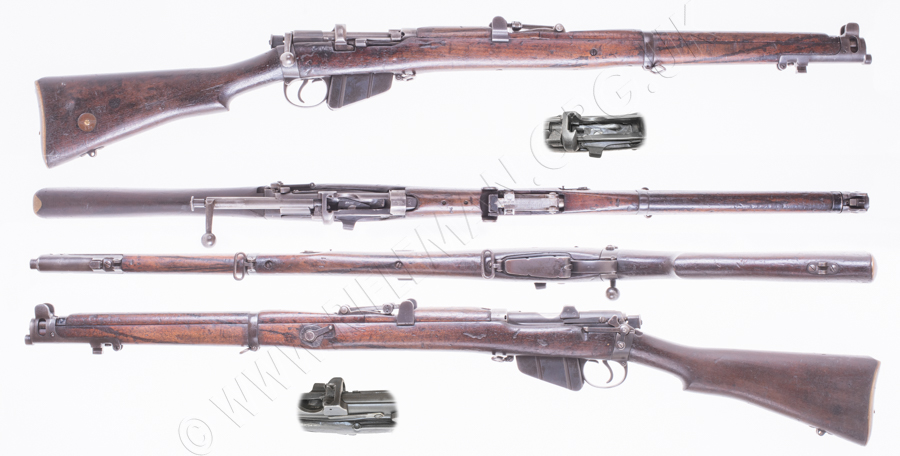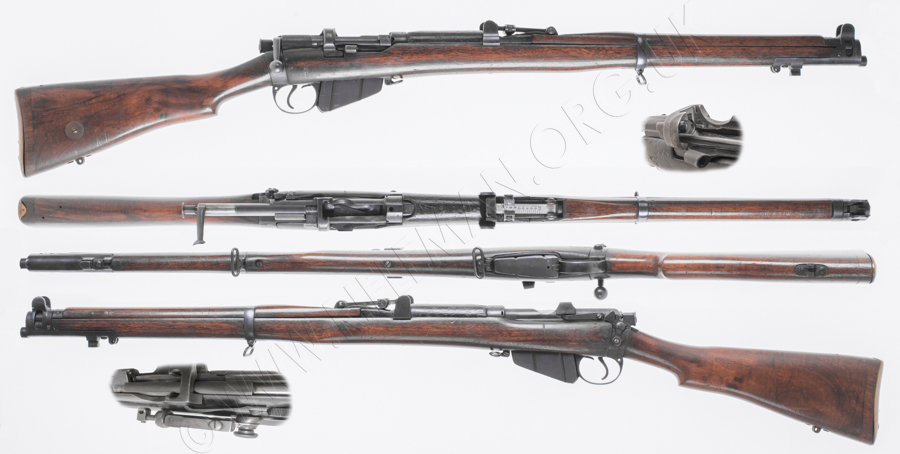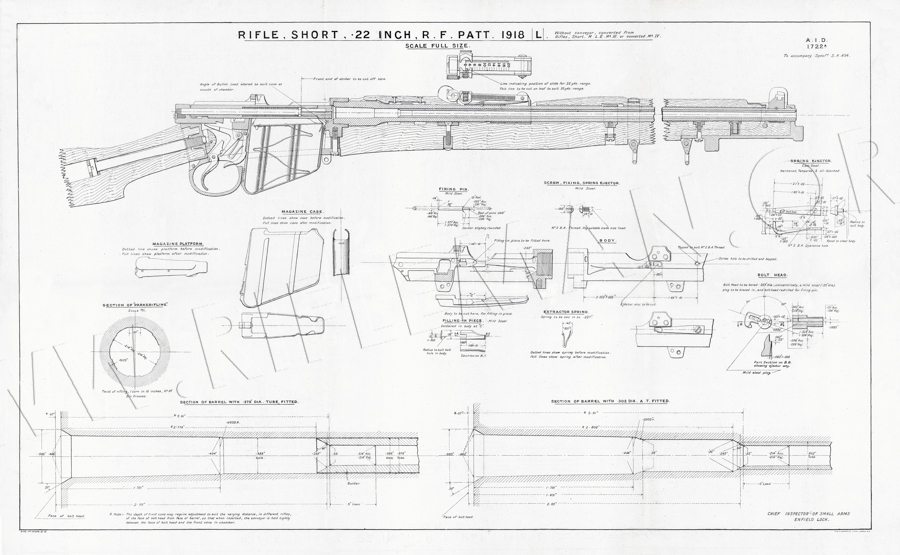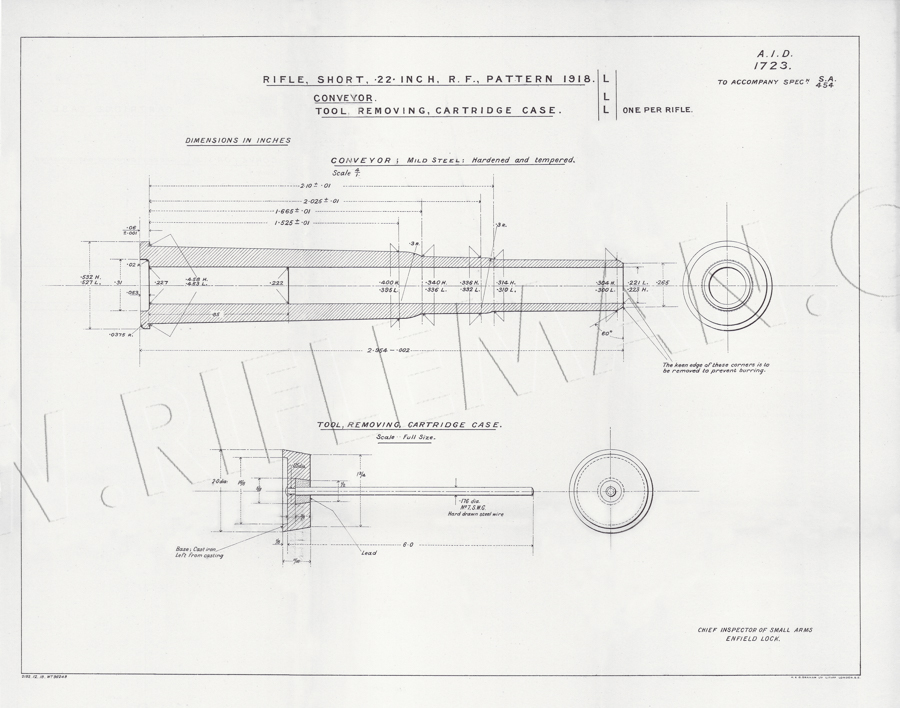The Rifle, Pattern '18, " .303in-cum-.22in "
Please be aware that some specialist imagery may take time to load.
This site is for dedicated researchers and is best viewed on desktop.
Below is the unusual Pattern 18 A.G. Parker conversion of the .303" Short Magazine Lee-Enfield to .22" calibre, with its "conveyors" in cartridge clip in the charger bridge - waiting to be thumbed down into the magazine.

This rifle was submitted to the military for trials in early 1917.
Hover over or Click image to bring up hi-res file and magnifier
By courtesy of the curator of the Weapons Collection, at the School of Infantry in Warminster, we are able to show a facsimile of the report made 'under minute number 183, to the Small Arms Committee on 16th. May 1917.
MUNITIONS DESIGN COMMITTEE.
SMALL ARMS SECTION.
16th May, 1917.
Present:
Col. G. H. S. BROWNE, C.B.
Lieut.-Col. C. R. B. OWEN,
Lieut.-Col. A. HANDLEY.
Lieut.-Col. H. W. TODHUNTER.
Major the Hon. R. ATKINSON.
Col. the Hon. T. F. FREMANTLE (Secretary).
Minute (S.) 183.
ADAPTER FOR USING .22
AMMUNITION WITH 1914 RIFLE (PARKER).
16..5. 1 7 D.G.M.D. /A. /236.
C. M. I. D. 7.5.17, to D.G.M.D.
I send herewith one S.M.L.E. Rifle, No.
10009, which has been converted by
Messrs. A. G. Parker and Co. to .220 bore and chambered to take the
steel " conveyors " for .220 ammunition in accordance with
their service-cum-miniature system. Fifteen steel " conveyors " are
also forwarded.
Messrs. A. G. Parker and Co. inform me that the
ejecting screw does not operate satisfactorily with the
steel carriers, and for that reason it has been found necessary to fit a
special ejector to the rifle.
I attach sample targets showing the quality of the shooting.
Referred
to the Munitions Design Committee by D.D.G.(S.) for consideration.
Action taken -
Reported to D.D.G.M.D.
The Committee would be glad to see the sample 1914 rifle
when ready, but, do not see any case for the adoption of this
system for the S.M.L.E., especially in view of previous decisions on the
subject of adaptors.
It will be noted that, although many of these conversions were later attributed to Parker-Hale, the company eventually combining A.G. Parker and Arthur Hale, the initial submission for the design was from A.G. Parker himself. See the Parker and Parker-Hale Companies. Alfred Parker's comment that the ejecting screw for their previous Pattern '14 .22LR training rifle was not fully effective with the heavy steel conveyors, requiring a significant specially-made ejector spring that can be seen in our photographs, and will be covered separately further down this page.
The reference to the Pattern 1914 rifle was because it was that model of .22 training rifle, produced using A.G. Parker's Parkerifling system to fire single-loaded rimfire long cartridges, that had these four years later been modified to the Pattern '18 to utilise the new .303-cartridge-sized conveyors to fire the .22LR round in realistic magazine-fed full-bore fashion.
At that point, it appears that the S.A.C. did not feel this training conversion particularly worthy of consideration. At a time when manufacture of arms of all types were under the greatest of pressure, it would seem that adaptors of almost any nature were not deemed a priority. It is worthy of note that the secretary of the committee was none other than the author of the famous tome "The Book of the Rifle"; Colonel, the Honourable T.F. Fremantle.
An interesting point here is that the first rifle submitted was described simply as a converted S.M.L.E., and the sample of a Pattern '14 rifle was awaited. By mid-June the "Pattern '14" rifle had been submitted and the committee further considered its merits. Since the War Office eventually gave the Parker converted S.M.L.E. rifle the nomenclature Pattern'18, because of its original date of introduction, it is evident that Parkers submitted both a converted S.M.L.E. and a converted Lee-Enfield Rifle No.3, more commonly known as the U.S. Pattern '14 - not to be confused with the S.M.L.E. .22 Pattern '14 which carried the full title of "Rifle, Short, .22-inch, R.F., Pattern 1914".
In spite of the comments of the committee in June 1917, the Pattern '18 S.M.L.E. version was, as has been written, adopted in 1918, while the .22 Rifle No.3 (the training conversion of the .303 calibre Service Rifle better known as the .303 P'14 - the Enfield designed rifle manufactured in the U.S.A.) was never militarily introduced, and seems only to have been supplied to the civilian market or 'volunteer' style units in very small numbers.
CONFIDENTIAL
MUNITIONS DESIGN COMMITTEE.
SMALL ARMS SECTION
13th June, 1917.
Present:
Col. G. H. S. BROWNE, C.B.
Lieut.-Col. A. HANDLEY.
Lieut.-Col. H. W. TODHUNTER.
Major the Hon. R. ATKINSON.
Major R. (Ti. BALL.
Col. the Hon. T. F. FREMANTLE; (Secretary).
Minute (S.) 195.
DEVICE FOR USING .22 AMMUNITION WITH 1914 RIFLES ( PARKER ).
13.6.17. D.G.M.D./A./ 286 28082. Previous Minute (S.) 183.
Munitions Inventions Department, 4.6.17, to D.G.M.D.
Herewith one 1914-pattern Enfield Rifle No. W. 23818, which has been converted to .220 bore.
Five steel "conveyors '' are also forwarded.
The method of converting the bolt for the -220 rim fire cartridges is shown in the. drawings and description. attached. Sample targets to show the quality of shooting are also attached.
Messrs. Parker's description of the method of contversion of the Enfield pattern. 1914 .303 rifle to the Parker Hale .303 cum .22-in,. cartridge system.
The bolt is converted from centre fire to rim fire in the manner shown in the accompanying drawing.
The barrel, is converted from .303 in. to .22 in. on the Parker Rifling System, except that the chamber is bushed solidly, drilled and bored. The barrel is then tubed for its entire length and chambered specially tor the conveyors.
There being no adjustment possible on the bolt, the far end of the chamber on which the conveyor rests, and so prevents escape of gas, is carefully finish-bevelled to gauge, in conjunction with the bolt.
Owing to the difference in the shape of the pointed bullet of the Service cartridge and the dummy bullet of the .22 conveyor, it was found to be necessary to remove any material which interfered with the dummy bullet and so prevented it acting normally.
On examination it will he found that we have scraped away small portions of the action body at the forward end of the magazine underneath the ledges at either side.
The slope leading into the chamber has been widened.
The forward end of the magazine platform has been filed to clear the dummy bullets, and a guide has been soldered under the rear end of the platform to position it, this being necessitated by the removal of material from the body at the forward end.
Referred to the Munitions Design Committee, by.D.D.G.(S.) for consideration.
•
Action taken—
Reported to D.D.G.M.D.
The Committee consider the necessity for altering the rifle to suit this device to be a serious drawback, and in view of past experience of adapters they do not propose to recommend.
The Lee-Enfield Rifle Pattern 1918 in .22 RF
This rifle conversion (known as the .303" cum .22" ) provided what was probably the most realistic loading system and action
weighting of any of its period. The design offered rimfire cartridge "conveyors"
of fullbore cartridge dimensions. 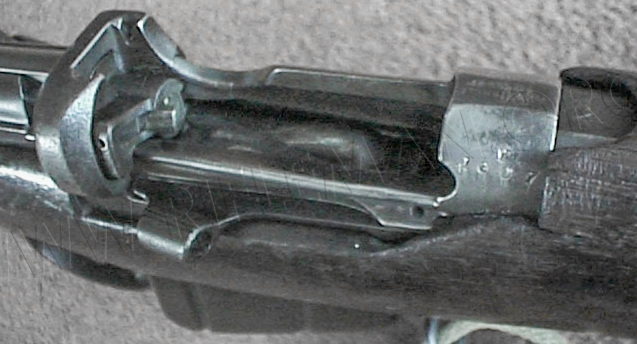
(see The Williams Floating Chamber and The Morris and Aiming Tubes)
The picture to the left shows the receiver with charger guide bridge
and the .22" bolt head with offset firing pin. Unlike most .22"
conversions, the extractor is full width, as on the .303" parent
arm. An auxiliary ejector was fitted to the left hand side of the receiver
in a freshly machined slot. It was a rather agricultural addition, but
proved necessary to assist in the ejection of the heavy steel conveyors (see picture below left). 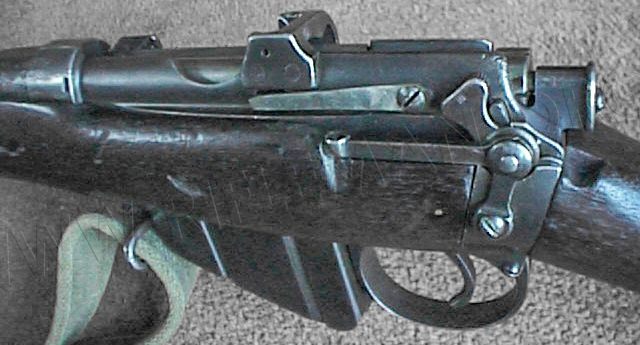
The steel conveyors were smoothbored and chambered for the .22" rimfire
long rifle round. A loading tool was provided to press the rounds into the
conveyor, flush with the rim. It was also used to press out the fired empty
case. This meant that a man had to be dedicated to clearing and loading
the conveyors, not conducive to ease and speed of use. This was probably
one factor in the system's limited use in the Military. It was phased out
after ab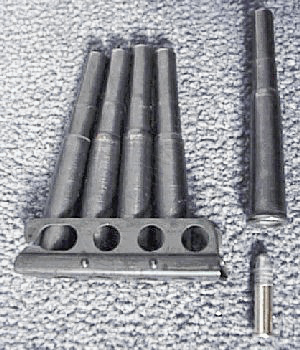 out only two years in
operation. Another minor problem was that the necessary blunt end of the
conveyors did sometimes result in a breech jam which the pointed full bore
bullet almost (but not completely) precluded. The most significant drawback
was the lack of obturation. Unlike a brass cartridge case, the conveyors
did not expand into the .303" chamber. The resultant gas leakage is
considerable, and any person shooting one of these rifles today would be
well advised to wear safety glasses! The image below right shows the conveyors
feeding from the magazine. The cut-off was left on these rifles, and is
still best used for single shot practice. Parkers bored the original
out only two years in
operation. Another minor problem was that the necessary blunt end of the
conveyors did sometimes result in a breech jam which the pointed full bore
bullet almost (but not completely) precluded. The most significant drawback
was the lack of obturation. Unlike a brass cartridge case, the conveyors
did not expand into the .303" chamber. The resultant gas leakage is
considerable, and any person shooting one of these rifles today would be
well advised to wear safety glasses! The image below right shows the conveyors
feeding from the magazine. The cut-off was left on these rifles, and is
still best used for single shot practice. Parkers bored the original 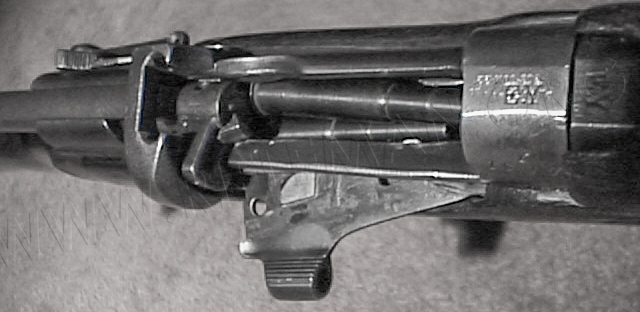 barrel
and fitted a sleeve along the lines of their
barrel
and fitted a sleeve along the lines of their
famous "Parker Rifling" process. Although declared obsolete for military use in 1920, a small number were later sold commercially and a sibling system was still advertised in the Parker-Hale catalogue of 1933, but as "applied to Vickers Machine Guns for non-automatic firing practice on miniature ranges".
This shot of the muzzle well illustrates the sleeving. Close inspection
shows either the use of a steel olive at the front of the sleeve - a precursor
to the brass ones later fitted to Parker
Rifled arms, or perhaps indicating the fitment of a replacement at
some stage in this example's lifetime. In good overall repair, the weapon
shows typical signs of significant use, and has the stain marks down the
woodwork born of regular cleaning at a time when black powder was the
propellant, and of having been frequently stood in the rack without being
wiped down.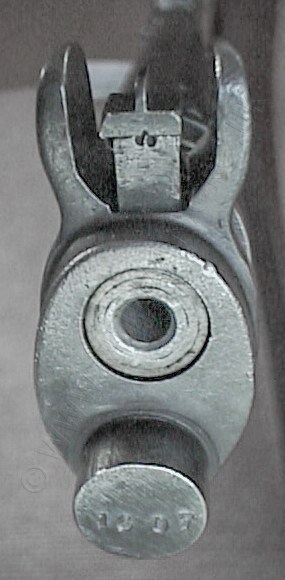 ............................
............................
.......................
PARKER-HALE
.303" CUM .22"
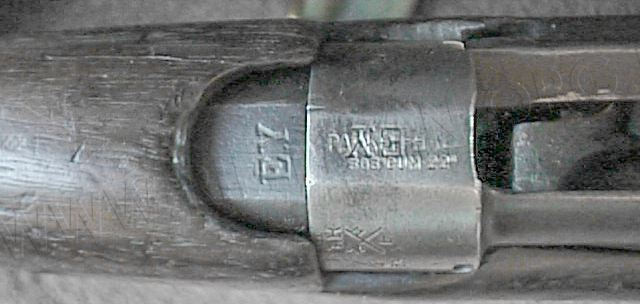 ~
~
and the barrel reinforce has a multiplicity of
markings for modifications and proof with the
~ 22" SLEEVED ~ stamping being prominent.
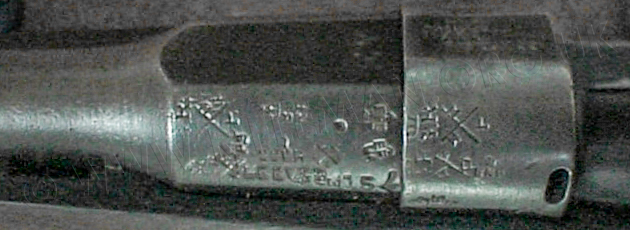
The right hand side of the butt socket has the original markings of Enfield manufacture
~ Sht. LE ~
III
below which was added
~ & Co. Ltd. BIRMINGHAM .22 PATT' 18 " ~ The line above "& Co. Ltd" is missing, either poorly impressed or ground from the stamp. It is possible that it would have read - A.G. PARKER ~ since the two companies were so closely entwined.
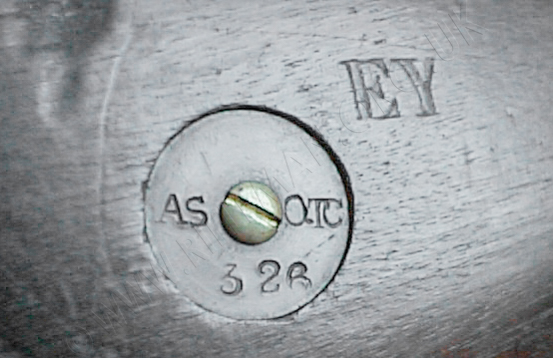
The long range rear aperture and dial sight are retained.
The bolt head is a modification of the .303"original with the "U" stamp, rather than
the later purpose manufactured ".22" head. The butt stock disc gives the unit to
which the converted rifle was issued as the Officers Training Corps. An unusual
career's end for a 1912 Enfield manufactured S.M.L.E. Mk.III. If only such historic
items could tell their tale..........
As already mentioned, when the Lee-Enfield P'18 was no longer issued by the military, Parker-Hale naturally continued to sell them on the civilian market. BSA manufactured commercial models were converted for sale, and one of these is illustrated below.
Hover over or Click image to bring up hi-res file and magnifier
Below is the loading tool as illustrated in the advertisement beneath. With the hand lever to the side shown, the fresh cartridge is pressed ( carefully) into the conveyor. The standing post on the right hand side receives the ejected conveyor carrying the fired cartridge case. The conveyor is slid over the post, neck downwards, and the lever brought over to that side. The empty case is then pressed out of the conveyor through the clearance hole in the lever arm. To keep a squad of recruits on the firing points supplied with ammunition would have been no mean task!
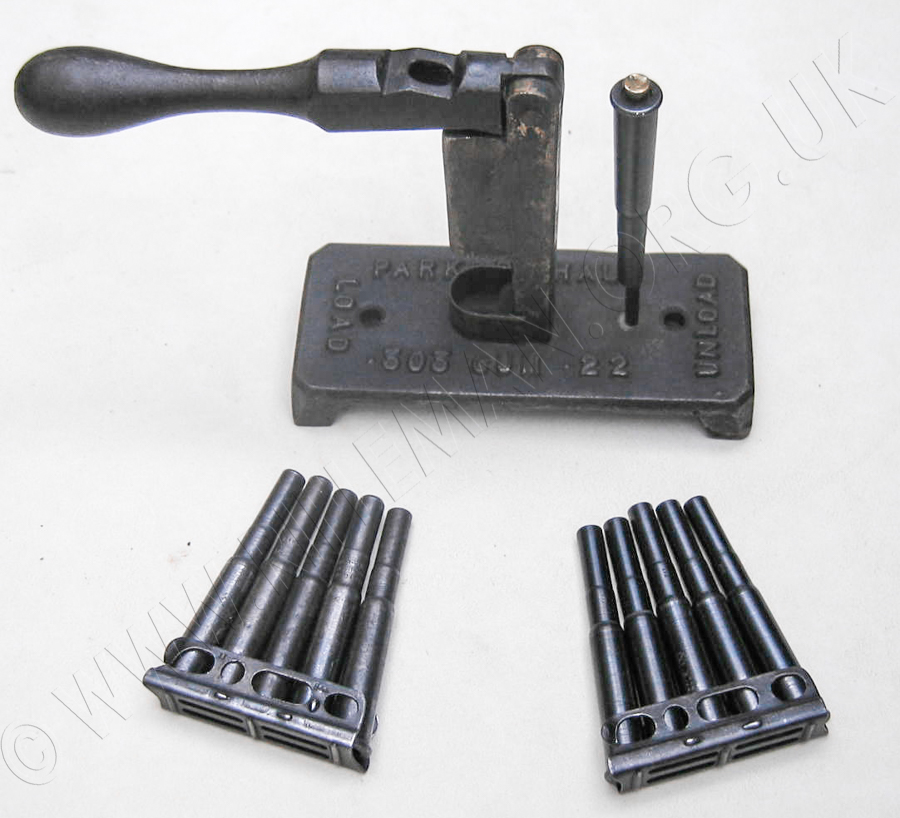

Below right is an advertisement for the equivalent equipment for use with the Lewis machine gun.
The fabricated rod tool below, one of a pair of designs, is purported to be the device for pushing the fired empty cases out of the conveyor.
The sliding leather washer fitted over the rod appears to be the same part that is normally placed over the stock fixing bolt head, in the Enfield rifle butt, to protect the oil bottle there stored.
 .................................
................................. 
The specification for the Pattern 1918 rifle was issued in a Small Arms Document referenced SA 454. This confirmed approval for the rifle on 27th. January 1919. There were two SAID drawings associated with the specification, one for the rifle, components and chamber detail, and one for the conveyor and an unloading tool that was perhaps superceded by the one shown above. The former was Drg No. AID 1722A and the latter AID 1723, both dated at December 1918.
These drawings follow the PDF of the specification, and are here illustrated by courtesy of, and also copyright to, the Royal Armouries. The PDF and the drawings have been carefully processed by Rifleman from the original scans to improve their display.
These text-searchable documents can be viewed with vertical scrolling
or as flip-pages by clicking the appropriate icon.
Depending upon the number of pages they may take a few moments to load.
Double tap tablet or click ![]() for full page display. ESC to return.
for full page display. ESC to return.
Hover over or Click image to bring up hi-res file and magnifier
Hover over or Click image to bring up hi-res file and magnifier
Click below to access a
Chronology of Enfield genre Training Rifles, Adapters & Cartridges
